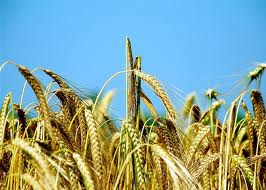A year ago, my homebrewing friend, Chad, gave me a sample of his 100% wheat beer experiment (the results of which you can read about here). It was a really cool lesson in the effects of wheat on beer. Well, this past fall, Chad went one step further in his crazy genius exploration of alternative grains. He recently did a 100% rye beer. Now, unlike wheat – which is often used as high as 50-60% of the malt bill, rye is usually kept to a more moderate amount – usually under 20% in even the most ardent rye beer. In part that is because rye has a reputation for adding a harsh, angular character to the beer, something you likely don’t want too much of.
So kudos to Chad for attempting this experiment. His brew-in-a-bag set up is perfect for this kind of thing, as it makes problems like stuck sparges simply go away. However, he reports that it was one of the weirdest mashes he has ever experienced. He said the rye malt turned into an odd gel that refused to liquefy. He also got a paltry 40% extraction rate (for those of you not homebrewers, extraction is the amount of fermentable sugar you successfully pull out of the grain – and 40% is really low). The resulting beer was only 3% alcohol. A final important point is that he used a German Weizen yeast for the beer.
So how did the beer taste? Quite interesting, all told – and not what I was expecting.
It pours dark copper with surprisingly good clarity topped by a large, dense white head. The aroma is spicy with pepper and Belgian phenolic earthiness. I also pick up soem rounded caramel and toffee sweetness. The beer has a silky, soft mouthfeel – not at all what I anticipated. It starts almost soapy with a light caramel upfront. I find it starts to sharpen in the middle and some of that expected rye edge makes its presence known. The finish is sharp, spicy and earthy. I pick up some clove and pepper as well. The body seems fuller and richer than a simple one-grain 3% beer.
I spent a fair bit of time sipping this beer – wanting to figure out what I was detecting. It was both more complex and less “rye-like” than I thought it would be. The beer presents like it has been pitched with a saison yeast, not a weizen yeast, and is softer than a rye beer might be.
Here is my theory on this. I think the combination of the rye malt and the weizen yeast are mimicking the effects of a saison yeast. The sharper, spicier rye malt mixes into the clove and bubblegum expected from weizen yeast to create a saison-esque beer. Chad may have stumbled onto something. Possibly weizen yeasts offer a nice contrast to the sharp rye, allowing for a softer overall impression. In other words, this might be a way to increase rye additions above traditional amounts without creating too much angular edge.
And then there is the issue of how much flavour and body this ultra-light beer offers. Coors Light could learn a thing or two from Chad’s techniques.
Overall yet another fun, educational experiment from Chad. He is threatening an all oat beer next.


November 21, 2012 at 11:38 AM
Sounds oddly good. The WildRose/Cowtown Yeast Wranglers Rye Saison was one of the best Alberta beers of the year in my opinion, so I could see this being drinkable.
November 21, 2012 at 2:04 PM
I recall trying a “Ryewine” made with 100% Rye at a homebrewer’s guild meeting last year. I don’t know what the differences in setup might be, but that guy certainly got more than 40% efficiency, ’cause it packed a bit of a wallop. Very dry and sharp, too, but quite drinkable.
I’ve always loved rye beers, rarely brew without it and will buy almost anything with it, so it’s been great to see how many rye beers we can get now compared to not long ago when even most of my fellow beer geeks had never seen one.